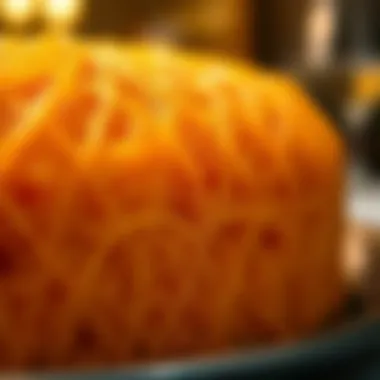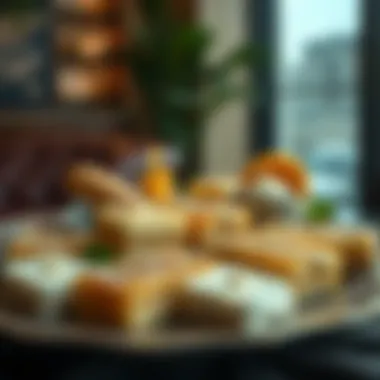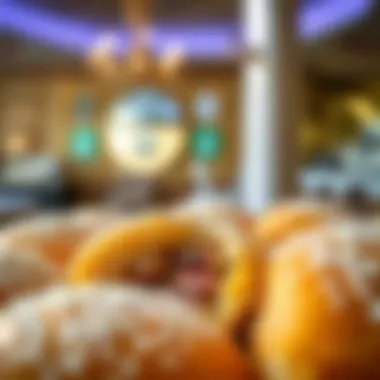Discovering the Finest Kunafa in Dubai


Intro
In recent years, Dubai has carved its niche as a culinary capital of the Middle East, attracting food enthusiasts from all around the globe. Among the plethora of delights that this vibrant city has to offer, kunafa stands out as a quintessential dessert that embodies the essence of Arab hospitality and tradition. This dish, known for its delicate layers and sweet syrup, has a rich history and holds significant cultural weight within Emirati dining.
As diners stroll through the bustling souks and modern malls, the aroma of roasted nuts and fragrant sugary syrup wafts through the air, drawing them toward establishments that serve this beloved delicacy. From cultural gatherings to celebrations, kunafa has a seat at every table, telling a story that transcends generations. This article aims to deepen the understanding of kunafa's place in Dubai's food scene by exploring its origins, diverse styles, and standout venues where the finest iterations can be savored.
In navigating through this guide, readers can expect to discover not just the best places to taste kunafa, but also gain insights into the varying forms it takes—from classic filigree noodles to modern interpretations featuring innovative twists. Whether you’re a resident eager to reconnect with your heritage or a visitor looking to indulge in authentic flavors, this exploration promises to shed light on the best kunafa experiences that Dubai has to offer.
By the end of this article, we hope to equip you with a discerning palate and a map of culinary excellence—all while appreciating the stories, techniques, and lore that each bite of kunafa encapsulates. Let's dive into the world of this exquisite dessert and uncover what makes it a staple in Dubai's diverse gastronomic landscape.
Understanding Kunafa
Kunafa isn't just a dessert; it's a bit of cultural history wrapped in a delightful pastry. For anyone who finds themselves in Dubai, understanding kunafa means grasping a significant aspect of Middle Eastern culinary heritage. This golden treat is more than something sweet to satiate cravings; it serves as a bridge between tradition and modernity, evoking cherished memories and communal ties.
Historical Background
To appreciate kunafa fully, one must wander back through time to its historical roots. Originating from the Middle East, its precise beginnings can be as murky as its delectable syrup. Many believe kunafa emerged in the kitchens of the Ottoman Empire, with variations evolving in countries such as Palestine, Turkey, and Egypt. Even a casual glimpse at ancient manuscripts reveals references to sweet pastries that echo today’s kunafa recipes. The dessert found its way to every corner of the Arab world, transforming local ingredients into something unique and memorable.
Kunafa’s history tells a broader tale of culinary exchanges. Imagine caravans laden with spices and sweets, where every dish carries a story from the past. The tradition of preparing and sharing kunafa during special occasions persists, often signifying hospitality and celebration.
"Kunafa encapsulates a rich tapestry of flavors that transcends time, bringing people together over centuries."
A Culinary Staple in the Arab World
In the Arab world, kunafa is much more than a mere dessert; it anchors festivities and community gatherings. Whether during Ramadan iftars or lavish wedding banquets, the warmth of kunafa fills the air with a sense of familiarity and belonging. Each region has its preferred way of preparing this treat, contributing to its status as a culinary staple.
For many families, preparing kunafa is a ritual passed down through generations. The art lies not only in the ingredients but also in the stories and traditions interwoven in each dish. As households come together to create kunafa, they embrace their heritage, preserving cultural practices that define their identities.
Variations Across Regions
The beauty of kunafa is in its endless variations, each one telling a local tale. In Palestine, for instance, Knafeh Nabulsi emerges with a distinctive flavor profile, relying on the famous Nabulsi cheese for its rich, salty filling. In Turkey, you might encounter a sleeker version known as künefe, often adorned with pistachios and drizzled in fragrant syrup.
You can expect the flavors and textures of kunafa to shift as you cross borders:
- Cheese Kunafa: Typically made with fresh cheese, yielding a gooey texture that blends perfectly with the crispy pastry exterior.
- Nut-stuffed Kunafa: Often incorporating a variety of nuts, these renditions offer a crunch that contrasts beautifully with the soft layers.
- Savory Variants: Some regions dare to step outside the sweet sphere, creating savory versions that add a whole new dimension to kunafa.
Each type not only showcases regional tastes but also highlights the creativity and resourcefulness of the people behind the recipes. This adaptability has made kunafa an enduring favorite, embodying the spirit of innovation in Middle Eastern cuisine.
The Art of Making Kunafa
The process of making kunafa is a delicate art, woven into the social fabric of Dubai's culinary tradition. Understanding this craft elevates an appreciation for this beloved dessert. Kunafa is not just food; it's a ritual, a spectacle that engages multiple senses. In Dubai, where culinary artistry meets cultural legacy, the craft of kunafa serves both as a nod to history and as an invitation for innovation.
Traditional Ingredients
At the heart of kunafa's appeal lies a blend of quality ingredients. The foundation consists of a dough called kataifi, which resembles thin strands of hair, contributing to the dish’s signature texture. This dough is generally made from flour, water, and a hint of salt, yet it is the precise technique of shredding that creates its unique layering. For the filling, the choices vary widely, but one must often choose between a traditional cheese filling, often made from fresh mozzarella or a rich cream known as ashta.
Additionally, sugar syrup sweetened with orange blossom or rose water must be considered. This gives kunafa an aromatic dimension, balancing the flavors beautifully. Spices like cinnamon and pistachios may also be sprinkled on top, raising the dessert's flavor profile and eye appeal.
Significance of Quality Ingredients


- Local Sourcing: Many renowned bakeries in Dubai opt for locally sourced ingredients, which not only ensure freshness but also support local farmers.
- Seasonal Variability: The use of seasonal ingredients allows for the possibility of unique, innovative variations, making kunafa an evolving experience.
Techniques and Preparation
Creating kunafa can be both straightforward and complex, depending on the desired outcome. The first step involves the preparation of the kataifi dough. Chefs often spend hours shredding the dough to the perfect consistency, ensuring it will fry evenly to achieve that golden crust. The technique of layering is crucial; too thick a layer or uneven distribution can affect texture.
Next comes the filling. When filled with cheese, the layers must be carefully balanced to avoid any overwhelming saltiness. For the ashta filling, precision in the cooking process and temperature control is essential to achieving the right consistency.
The baking process involves a unique method. Kunafa is typically cooked using hot air convection, which creates a crisp outer layer while keeping the inside chewy. As it cooks, the aroma fills the space, making it almost impossible to resist.
Key Preparation Steps
- Prepare the kataifi dough by shredding it finely.
- Layer the dough and filling expertly to maintain taste and texture balance.
- Use a proper cooking method to ensure evenness and quality in the final product.
Serving and Pairing Suggestions
Kunafa dazzles when served fresh and hot. Many chefs recommend drizzling sweet syrup over the top immediately after it comes out of the oven, allowing the flavors to meld beautifully. Topping it with crushed pistachios or a sprinkle of cinnamon transforms the presentation drastically, adding both color and flavor contrast.
When it comes to pairing, a cup of Arabic coffee is a classic choice, complementing the sweetness and enriching the overall experience. Alternatively, herbal teas infused with mint can enhance the flavors, offering a refreshing contrast.
For a genuine experience, try enjoying kunafa in an authentic cafe within Dubai, where the process is often showcased as part of the dining experience.
In summary, the art of making kunafa is not just about following a recipe; it is about the passion and commitment to quality that each chef brings to the table. The attention to detail in both ingredient selection and preparation techniques results in a dish that is rich in flavor and legacy.
Top Destinations for Kunafa in Dubai
Historic Cafes and Bakeries
The charm of historic cafes and bakeries in Dubai lies in their ability to transport you back in time. These establishments, often passed down through generations, serve kunafa that is steeped in tradition. A visit to one of these cafes often feels like stepping into a living history.
One such gem is Al Ameerah Restaurant, where the kunafa is crafted using an age-old family recipe. Here, the cheese is carefully layered with the thin, crisp noodles, and it is baked to a golden hue, resulting in a crispy exterior with a gooey interior. It’s a treat for the senses, and it resonates with the essence of authentic Arab hospitality.
In addition, Bakery Al Maktum has built a reputation over the years for its exceptional kunafa, made fresh daily. It offers a cozy ambiance and an array of other traditional desserts that perfectly complement the kunafa experience. The charm of such establishments is not just in their food, but also in the stories that accompany them.
Modern Patissiers and Their Creations
As Dubai advances in its culinary scene, modern patissiers have taken the classic kunafa and given it a contemporary twist. This evolution maintains the essence of the dish while introducing innovative flavors and presentations.
One exemplary place is Petit Maison, where kunafa is offered in a delectable fusion with pistachio ice cream. This modern variation takes the traditional elements and elevates them to new heights, appealing to younger generations and food enthusiasts alike. The visual appeal alone is enough to make one pause; it is a treat for both the eyes and the palate.
Another spot worth mentioning is Wild & The Moon. Known for its focus on organic, locally sourced ingredients, this establishment promotes a sustainable approach to kunafa, blending healthy twists with the beloved classic. Here, you can find options like kunafa made with almond flour and cashew cream, catering to health-conscious diners without sacrificing flavor.
Cultural Institutions Featuring Kunafa
Cultural institutions in Dubai often reflect the culinary heritage of the region. Places like the Dubai Opera not only showcase art and performance but also highlight local cuisine, including kunafa. They serve this exquisite dessert as part of their dining experiences, often framed within the context of enriching cultural narratives.
Similarly, the Sheikh Mohammed Centre for Cultural Understanding provides visitors with an immersive experience into Emirati culture, where kunafa is a staple in their culinary presentations. Events often feature traditional meals, and enjoying kunafa in such settings fosters a connection to local customs and traditions.
These cultural touches are essential, as they give depth to the experience of savoring kunafa. The intermingling of food and culture reinforces the idea that kunafa is not merely a dessert, but a symbol of community and shared experiences.
In summary, Dubai’s diverse kunafa destinations, from historic cafes to modern patisseries and cultural centers, provide a rich tapestry for anyone interested in delving deeper into this iconic dessert. Each location offers not just a taste, but also a slice of the city’s culinary narrative.


Distinct Styles of Kunafa
Knafeh Nabulsi and Its Significance
Knafeh Nabulsi hails from the Palestinian city of Nablus, renowned for its delicate layers of thin pastry soaked in syrup. This version often includes a generous filling of soft, melted cheese, creating a delightful contrast between the crispy and gooey textures. The use of unique ingredients, such as orange blossom water, elevates its aroma and flavor.
The cultural significance of Knafeh Nabulsi is profound, as it represents the identity and heritage of Palestinian cuisine. When one indulges in a slice of this iconic treat, they are not just tasting dessert, they experience a piece of history and tradition. In Dubai, many establishments pride themselves on creating authentic Knafeh Nabulsi, often boasting recipes passed down through generations, ensuring that the essence of the dish is maintained.
Kunafa with Cheese: A Delightful Fusion
One cannot discuss kunafa without mentioning the tantalizing cheese variant. This style diverges from traditional recipes by incorporating cheese as a core ingredient. The most popular types of cheese used include Akkawi and Mozzarella, which bring an elastic quality to the dessert. When prepared, this kunafa usually has an inviting golden crust on the outside, while being warm and gooey on the inside.
This fusion not only pleases the palate but also reflects the innovative spirit of Dubai’s culinary scene. Chefs often experiment with flavors and textures, pairing different cheeses and adding unexpected elements like nuts or chocolate. As a result, Kunafa with cheese has become a bridge between traditional and modern takes on this classic dessert, appealing to both purists and adventurous eaters.
Innovative Twists on Traditional Recipes
As the culinary landscape of Dubai evolves, so do the recipes for kunafa. Chefs and bakers are continually finding new ways to reimagine this time-honored dish, resulting in an explosion of creativity. From matcha-infused kunafa to options featuring exotic fillings like pistachio and mango, innovation thrives in the world of kunafa.
Some establishments offer a bite-sized version of kunafa, making it a perfect treat for those who want to sample multiple flavors at once. Others might experiment with deconstructing the pastry, presenting the components in a modern, artistic style that enhances the dining experience. This creativity is not just about making kunafa visually appealing; it’s about reinterpreting a beloved classic for a new generation while honoring its roots.
"In Dubai, kunafa is not just a dessert; it’s a canvas for culinary artists, each flavor tells a different story."
In summary, the distinct styles of kunafa in Dubai encompass rich traditions, delightful fusions, and innovative transformations. From the globally cherished Knafeh Nabulsi to the contemporary twists that redefine expectations, each style offers a unique experience that continues to captivate those who venture into the world of this famous dessert.
Cultural Significance of Kunafa in Dubai
Kunafa is more than just a dessert; it embodies a rich cultural tapestry within Dubai. This sweet treat is interwoven with the traditions, celebrations, and everyday life of the Emirati people. In exploring the importance of kunafa, one must understand its dual role as a culinary delight and a cultural hallmark that fosters community ties.
Festivals and Celebrations Centered Around Kunafa
Throughout the year, kunafa takes center stage during various festivals and celebrations across Dubai. One of the most notable occasions is Ramadan, a month of fasting and reflection for Muslims. After a long day of fasting, families and friends gather to break their fast with a feast. Kunafa, often soaked in fragrant syrup, serves as a sweet finale to the Iftar meal, bringing smiles and joy to loved ones.
Another pivotal event is Eid al-Fitr, marking the end of Ramadan. This festival is a time for giving and gathering, where kunafa is commonly prepared in homes and shared among neighbors. The act of sharing food is deeply rooted in Arab culture, reinforcing bonds of hospitality and generosity. During these occasions, the establishment of large gatherings highlights the significance of community and the role kunafa plays in fostering fellowship.
The local food scene also embraces kunafa during artistic festivals like Dubai Food Festival. Chefs showcase their innovative spins on this traditional dessert, reflecting both modern culinary trends and the timeless appeal of kunafa. It’s a chance for food lovers to experience the dish in new, exciting ways, yet always hinting at its rich heritage.
Kunafa as a Symbol of Hospitality
In many ways, kunafa symbolizes hospitality in Emirati culture. Inviting guests to share a plate of kunafa signifies warmth, respect, and an eagerness to share joy with others. The preparation of this dessert often involves family collaboration, where everyone pitches in to create a dish that delights all who partake. This collaborative spirit extends the concept of hospitality beyond mere food; it encapsulates the essence of community and familial love.
When a visitor is served kunafa in someone’s home, it is an invitation to be part of a deeper cultural exchange. Not only does it reflect the host's culinary skills, but it also tells a story of tradition and the importance of relationships.
Moreover, restaurants in Dubai prioritize kunafa on their menus, not just for its taste, but for the emotions it evokes. Each bite carries the history and warmth of a culture that values togetherness. It invites you to savor not just the flavor, but the essence of belonging, where every platter of kunafa serves as a reminder that food is a means of connecting people.
In sum, kunafa in Dubai transcends its status as a dessert. It stands as a cultural artifact, a shimmering thread in the rich fabric of Emirati society, rooted in tradition, celebration, and profound hospitality. As one enjoys this delightful treat, they partake in a legacy, savoring the sweetness of both the dish and the connections it creates.
Sustainable Practices in Kunafa Production
The growing demand for sustainability across various sectors has reached the culinary world, including the production of traditional desserts like kunafa. This expansion begins with a focus on the ingredients used, the processes involved, and the overall impact on the environment. Kunafa, often prepared during special occasions in Dubai, must adapt to align with modern sustainability principles. As chefs and bakers innovate, understanding sustainable practices becomes critical in maintaining not just the quality of the dessert, but also the health of the planet.
Locally Sourced Ingredients


One of the most effective ways to enhance sustainability in kunafa production is by sourcing ingredients locally. This approach not only supports local farmers and producers but also reduces the carbon footprint associated with transportation. In an age where global supply chains can lead to inconsistencies in quality, using ingredients from nearby farms ensures freshness and enhances the flavor profile of the dish.
Common ingredients, such as semolina, flour, and nuts can be sourced from local markets or farms. Choosing local honey or rose water over imported alternatives strengthens ties within the community and keeps the tradition alive. Here are some benefits of using locally sourced ingredients:
- Quality Assurance: Fresher ingredients lead to better tasting kunafa.
- Economic Impact: Supporting local businesses strengthens the local economy and sustains livelihoods.
- Environmental Sustainability: Less transportation means reduced emissions, promoting a healthier environment.
Using these ingredients not only elevates the dish itself but also weaves a story of community, tradition, and care for the environment.
Environmental Considerations in Sweetmaking
The environmental implications of sweetmaking stretch far beyond just ingredient sourcing. Incorporating sustainable practices into the overall production process can substantially lessen the carbon footprint of kunafa production. For instance, energy-efficient ovens can reduce electricity usage while innovative water management practices, such as collecting rainwater for cleaning purposes, can aid in reducing waste.
Moreover, packaging plays a pivotal role in sustainability. The shift from plastic containers to biodegradable or compostable packages can effectively curb pollution. It’s essential to promote practices that encourage waste reduction and recycling within the industry as a whole. Here are a few environmental considerations bakers and chefs should keep in mind:
- Energy Consumption: Using ovens that consume less energy can lessen impact.
- Waste Reduction: Implementing systematic recycling processes helps manage waste effectively.
- Water Use: Optimizing water utilization in production steps minimizes waste.
The intersection of culinary artistry and environmental responsibility represents a bright path forward for the future of kunafa.
Collectively, these practices not just elevate the dessert's legacy in Dubai, but also honor the environmental responsibilities that today's food artisans take on. As kunafa continues to evolve, its foundation in sustainability will define how it is perceived both locally and globally.
Kunafa in the Age of Social Media
Social media has transformed the way culinary delights are experienced and shared across the globe. Kunafa, with its rich history, delightful textures, and visually stunning presentation, has become a viral sensation among food enthusiasts. Platforms like Instagram and TikTok offer a feast for the eyes, and they have played an enormous role in the aloha around kunafa in Dubai. This section delves into how social media enhances the kunafa experience and showcases the intricate art behind it.
Visual Appeal and Presentation
The first bite of kunafa often starts long before it reaches the mouth. The allure of kunafa lies in its presentation, an aspect that social media elevates to an art form. A well-plated kunafa, glistening under a drizzle of syrup and sprinkled with pistachios, doesn’t just taste heavenly; it looks almost too good to eat. Here are some factors that contribute to its visual appeal:
- Color Contrast: The golden hue of the kunafa against the green of crushed pistachios or the deep amber of honey creates a feast for the eyes.
- Layering: The beautiful, stringy layers of dough interspersed with gooey cheese or creamy fillings lead to interesting textures that entice viewers.
- Garnishes: Fresh mint leaves, edible rose petals, and innovative sauces can take a traditional dish to the next level, making it worthy of ‘likes’ and shares.
Kunafa’s presentation not only teases the taste buds but also invites everyone to share their experiences on platforms, showcasing the rich traditions of Middle Eastern desserts — turning a simple sweet into a state of mind.
Influencers and Kunafa Culture
In recent years, food influencers have capitalized on the rich culinary traditions surrounding kunafa, diving into the deeper meanings and tantalizing tastes of this dish. These influencers often tell stories that connect the audience to the culture of Dubai, bringing kunafa to the forefront of digital conversations. By sharing their personal experiences and reviews, they help to foster a deeper appreciation for this beloved dessert, making it more than just a treat, but an experience.
The integration of kunafa with social media has led to:
- Trending Challenges: Some influencers launch challenges such as "kunafa-tasting tours" where participants visit various establishments trying different types of kunafa, sharing their experiences online.
- Recipe Videos: Creators often post sleek videos that highlight both traditional and modern takes on kunafa, inspiring home chefs to recreate these desserts.
- Cultural Education: Many influencers take the time to explain the history and significance of kunafa within the Arab culinary tradition, thereby fostering a greater understanding and respect for Middle Eastern cuisine.
"Social media is more than a platform; it’s a canvas for culinary art. Kunafa is not just a dessert, but a story waiting to be shared."
By deftly blending food artistry and social networking, kunafa is transformed into an experience that not only tantalizes taste buds but also crafts memorable stories that connect people from all walks of life. As Dubai continues to flourish as a food capital, the influence of social media on kunafa’s reputation cannot be underestimated.
Culmination
With all things said and done, the journey through the world of kunafa in Dubai unveils its multifaceted significance not just as a dessert, but as an embodiment of culture and tradition. Kunafa traverses generations, tethering the past with the present, making it a staple at every festive gathering and family celebration. The diverse methods of preparation and the variations in recipes reflect the rich tapestry of Dubai’s culinary scene, fascinating both tourists and local connoisseurs alike.
The Enduring Legacy of Kunafa in Dubai
Kunafa's presence in Dubai is nothing short of remarkable. It has become a cherished symbol, resonating not just among locals but also attracting an army of food lovers from all walks of life. It serves as a reminder of the city’s heritage, illustrating how traditional foods can adapt to modern tastes while retaining their core identity. The continuous evolution is a clear indication of how kunafa stays relevant, appealing to diverse palates through innovation without losing its roots.
"Kunafa is more than a dessert; it’s a story made with threads of dough, a tale of sweetness, and a testament to the warmth of Arab hospitality."
Furthermore, the artistry involved in making kunafa is indeed honed through generations. From the meticulous craftsmanship in preparing the thin noodle-like dough to the delicate layering of flavors, each plate serves not only indulgence but also celebrates the hard work behind it. Each bite carries the whispers of tradition, creating an experience that extends beyond flavors.
Thus, whether one is a local or just visiting, indulging in kunafa is an imperative—an experience that encapsulates the essence of hospitality, tradition, and the sheer joy of shared culinary delights.















